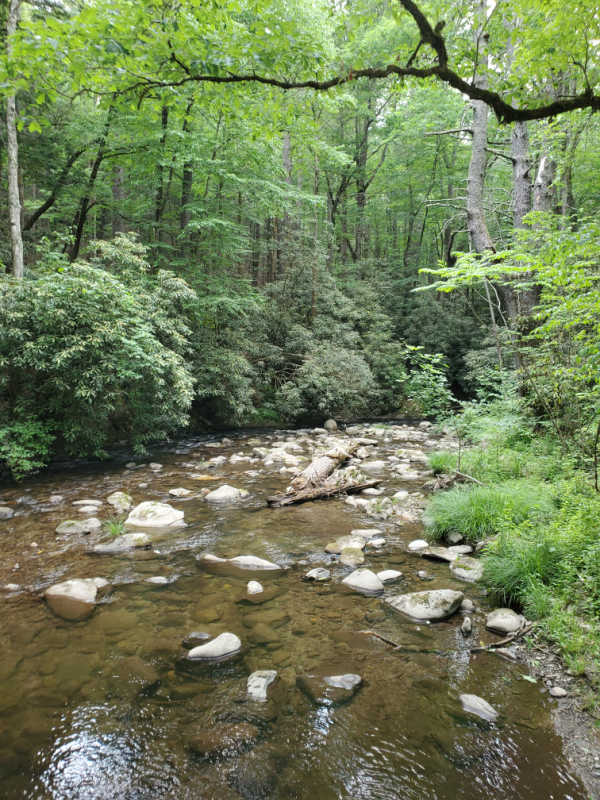Located on the Tennessee and North Carolina border is the most visited National Park of the country, the marvelous Great Smoky Mountains National Park. With a plethora of varying landscapes, the 522,426-acre region is sure to leave you awestruck!
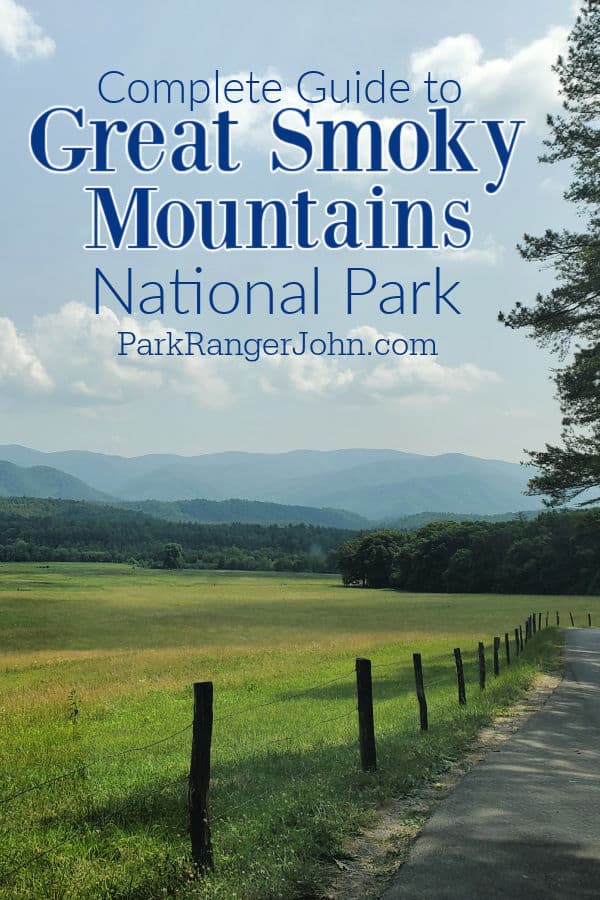
Great Smoky Mountains National Park
Home to breathtaking mountain peaks (as its name suggests), sprawling lush green forests, gorgeous cascading waterfalls, scenic trails, hikes, drives, and so much more, Great Smoky Mountains National Park is truly one of the most cherished parks in the US.
You may spot the famous Black Bear, the White-Tailed Deer, Elk, Chipmunk, or any of the 200+ species of birds that call the park home.
The park is also well-known as the Salamander capital of the world, with over 30 species amongst many other varieties of fish and aquatic life.
Whether you visit in the autumn time when the leaves turn all kinds of colors or watch the sun come up in the first few days of spring, you’ll love discovering the gems that the National Park has to offer.
With so much to see, explore, and absorb from the surroundings, your visit to this park with the beautiful Appalachian mountains in the backdrop is sure to be a trip of a lifetime!
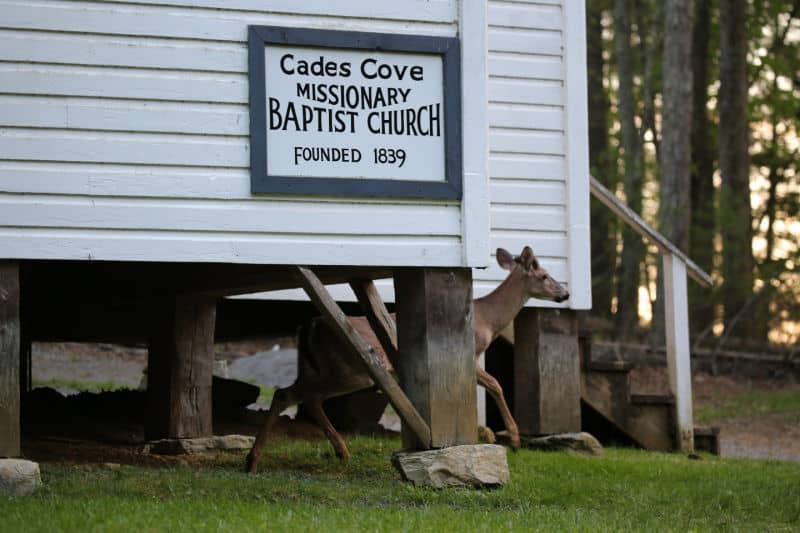
About Great Smoky Mountains National Park
As the most-visited National Park in the US, the Great Smoky Mountains National Park is loved for its diverse landscapes, flora, fauna, and breathtaking escapes that create memories to last a lifetime.
Covering 522,4326 acres of land, it offers several kinds of excursions - mountain hikes, fishing, biking, horse-riding, bird watching, wildlife viewing, and the list just goes on.
It is home to awe-inspiring nature trails like Cades Cove, a large fertile land that used to be a hunting ground for Cherokee Indians and is now one of the best spots in the park to catch wildlife.
Another sight you must visit is the Clingmans Dome, a 6,643 ft. peak which is, in fact, the highest point in all of Tennessee. While the hike is challenging and lengthy, the view of over 100 miles away (on most clear days) is more than worth it, so your hard work will pay off!
The park is also known for its beautiful waterfalls and trails like the Laurel Falls, Grotto Falls (and trail), and Abrams Falls (and trail). Including the waterfalls trails, the National Park is famous for its connected network of over 800 miles of trails that you can explore!
Within the park boundary is also one of the most rustic and chic lodges that sit atop the third-highest peak in the park, where you can stare at the unbeatable view of the valley as you doze off to sleep; if you’re feeling adventurous, you can camp in one of the many campgrounds that Great Smoky Mountains National Park has to offer.
The park is also connected via the Blue Ridge Parkway to the spectacular forests of the Shenandoah National Park if you’re hoping to make the best use of your all-access pass in one trip.
With the synchronous fireflies (which are one among 19 other firefly species in the Smokies) illuminating the pitch nights and the fresh foliage that covers the trails that you’ll traverse on an early morning hike to catch a stellar sunset, the Great Smoky Mountains National Park will impress you and keep calling you back!
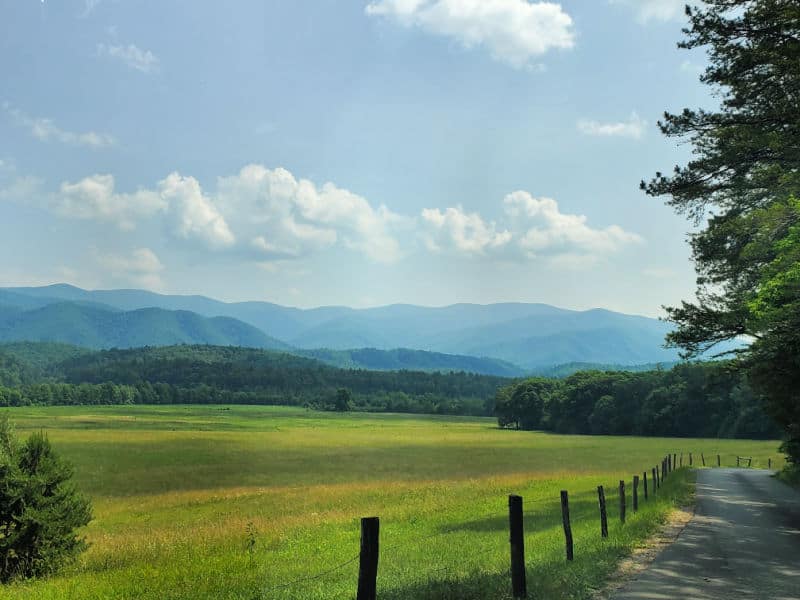
Is Great Smoky Mountains NP worth visiting?
YES! There is something for everybody in this national park! There is lush green forests, waterfalls, wildlife, breathtaking mountain scenery, and hundreds of miles of hiking trails just waiting to be explored.
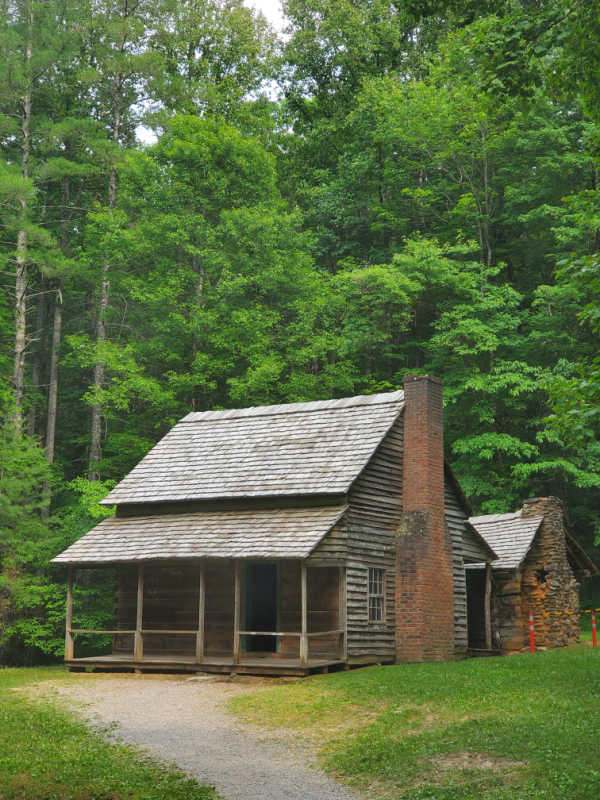
History of Great Smoky Mountains National Park
Besides being a marvel of the natural world, the Great Smoky Mountains National Park is also a region with a vibrant culture and history, particularly from the time it was the home for many indigenous peoples.
While it was declared an official National Park back in 1934, the history of the mountains, creeks, and forests in the region long precedes that.
For centuries, the area around the Appalachian Mountains was inhabited by many indigenous tribal groups, including the well-known Cherokee.
They built a life around the natural resources they were surrounded by, and unfortunately, much to their dismay, in 1830, the US President at the time, Andrew Jackson, signed the controversial Indian Removal Act, that caused them to be displaced from the place they called home for generations.
Post this act, several European-Americans began to move into the region and were followed by entrepreneurs and industrialists.
They set up The Little River Railroad, which caused a series of developments that were detrimental to the environment. In turn, locals and tourists at the beginning of the 20th century began to raise concerns about the destruction of nature.
The US National Park Service stepped in and hoped to seek out a national park in the Eastern part of the country, and the region seemed ideal.
Many politicians were involved, the US government donated funds along with private setters of Tennessee and North Carolina, and emerged triumphant in being able to remove miners and loggers from the region to establish the National Park.
It was officially dedicated as a National Park by President Franklin D. Roosevelt in 1940 and then received many other certifications as a region of natural beauty and wildlife preservation.
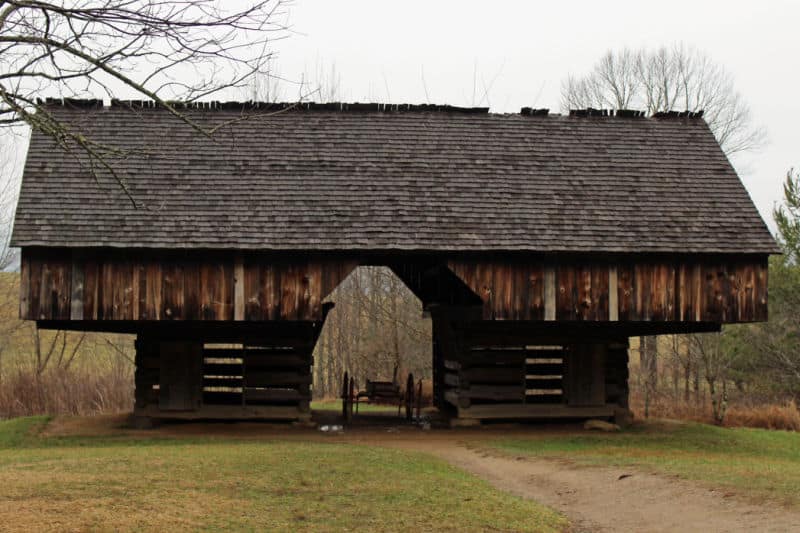
Things to know before your visit to Great Smoky Mountains National Park
Great Smoky Mountains National Park Entrance Fee
Park entrance fees are separate from camping and lodging fees.
Great Smoky Mountains National Park does not charge an entrance fee!
Great Smoky Mountains does have a Parking Tag Requirement
Daily - $5 Up to 7 Days - $15 Annual - $40 Parking Tag - Valid parking tags will be required for any vehicles parking in the Smokies starting March 1, 2023. Parking tags will not be required for motorists who pass through the area or who park for less than 15 minutes. Each tag will be valid for a single vehicle.
Click here to purchase a parking tag and for more information and informative video.
Learn more about National Park Passes for parks that have an entrance fee.
$80.00 - For the America the Beautiful/National Park Pass. The pass covers entrance fees to all US National Park Sites and over 2,000 Federal Recreation Fee Sites for an entire year and covers everyone in the car for per-vehicle sites and up to 4 adults for per-person sites.
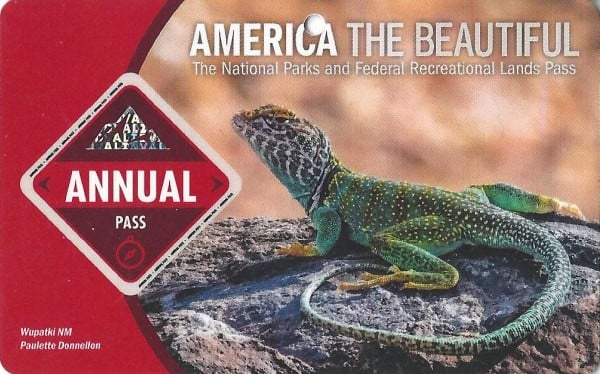
Buy your pass at this link, and REI will donate 10% of pass proceeds to the National Forest Foundation, National Park Foundation, and the U.S. Endowment for Forestry & Communities.
National Park Free Entrance Days -Mark your calendars with the five free entrance days the National Park Service offers annually.
Time Zone
EST - Eastern Standard Time
Pets
Dogs are allowed in campgrounds, picnic areas, and along roads, but must be kept on a leash at all times.
The leash must not exceed 6 feet in length. Dogs are only allowed on two short walking paths—the Gatlinburg Trail and the Oconaluftee River Trail.
The nearest kennels are in Pigeon Forge, Sevierville, Tennessee, and Cherokee, North Carolina
Cell Service
The cell service in the park can be a hit and miss. It varies according to your carrier and the part of the park you’re in.
It’s spotty throughout the park, but you may get lucky with the signal near the gift shop or any of the visitor centers.
Park Hours
The park is open 24 hours a day, all year-round. However, some campgrounds, roads, visitor centers, and other facilities may be closed in the wintertime.
In light of harsh weather conditions or the ongoing health crisis, parts of the park could be subject to closure so make sure you check the official website, follows the Smokies Official Twitter Handle or call (865) 436-1200 for regular and timely updates on closures.
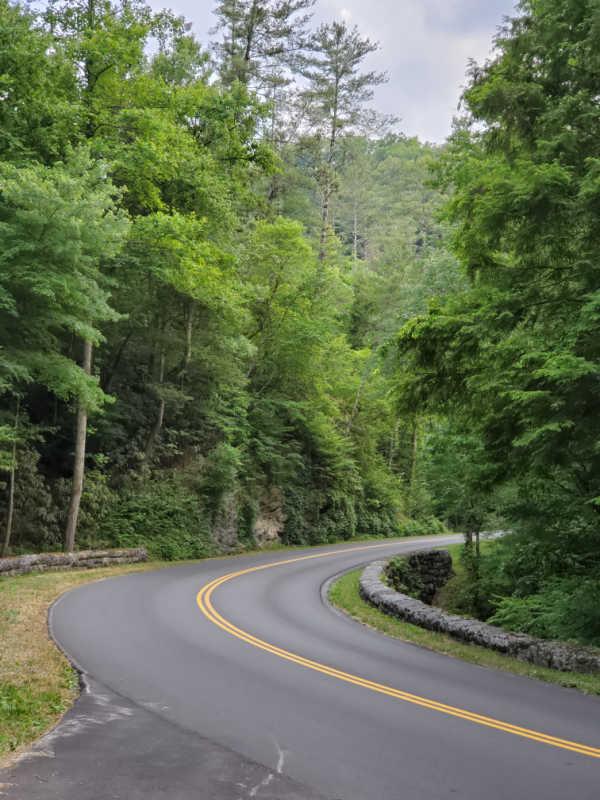
Wi-Fi
There is no Wi-Fi available within the park boundary.
It is reported by several visitors that you may be able to connect via hotspot near the Sugarlands Visitor Center. Otherwise, the nearest facility would be the Gatlinburg Public Library.
Parking
There are ample parking lots available at most major attractions like Clingmans Dome, Laurel Falls, and Cades Cove.
Some of the smaller trails and attractions may have smaller parking lots where it can be difficult for RVs to find space, so be sure to read up if you’re taking your van.
Food/Restaurants
There are no restaurants within the Great Smoky Mountains National Park.
However, essential snacks and beverages are offered at several spots, such as Cades Cove Campground Store, Elkmont Campground Concession, and others.
Gas
There are no gas stations within the park boundary. The nearest gas stations are located in Gatlinburg, Tennessee.
Drones
Drones are not allowed to be flown within National Park Service Sites.
Don't forget to pack
Insect repellent is always a great idea outdoors, especially around any body of water.
We use Permethrin Spray on our clothes before our park trips. Please read my article on preventing biting insects while enjoying the outdoors.
Sunscreen - I buy environmentally friendly sunscreen whenever possible because you inevitably pull it out at the beach.
Bring your water bottle and plenty of water with you. Plastic water bottles are not sold in the park.
Sunglasses - I always bring sunglasses with me. I personally love Goodr sunglasses because they are lightweight, durable, and have awesome National Park Designs from several National Parks like Joshua Tree, Yellowstone, Hawaii Volcanoes, Acadia, Denali, and more!
Click here to get your National Parks Edition of Goodr Sunglasses!
Binoculars/Spotting Scope - These will help spot birds and wildlife and make them easier to identify. We tend to see waterfowl in the distance, and they are always just a bit too far to identify them without binoculars.
Electric Vehicle Charging
The park has two EV charging stations near its Tennessee entrance (at the Sugarlands Visitor Center) and the North Carolina entrance (at the Oconaluftee Visitor Center).
You’ll also be able to find plenty of EV charging stations within Gatlinburg, Cherokee, and others.
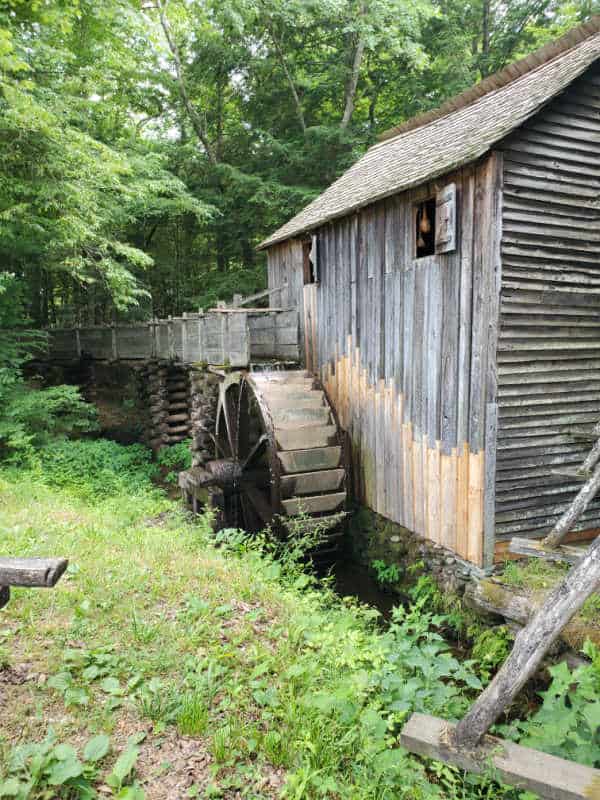
Details about Great Smoky Mountains NP
Size - 522,426
Great Smoky Mountains NP is currently ranked at 19 out of 63 National Parks by Size.
Date Established
The area was chartered as a National Park in 1934 and officially declared and dedicated by Franklin D. Roosevelt on September 2, 1940, as a place of “permanent enjoyment of the people.”
It was dedicated as an International Biosphere Reserve in 1976, a World Heritage Site (by UNESCO) in 1983, and a segment of the Southern Appalachian Biosphere Reserve in 1988.
Visitation
In 2021, the Great Smoky Mountains National Park was the most visited park in the country and had 14,161,548 visitors.
In 2020, Great Smoky Mountains NP had 12,095,720 park visitors.
In 2019, Great Smoky Mountains NP had 12,547,743 park visitors.
Learn more about the most visited and least visited National Parks in the US
National Park Address
107 Park Headquarters Road
Gatlinburg, TN 37738
Great Smoky Mountains National Park Map
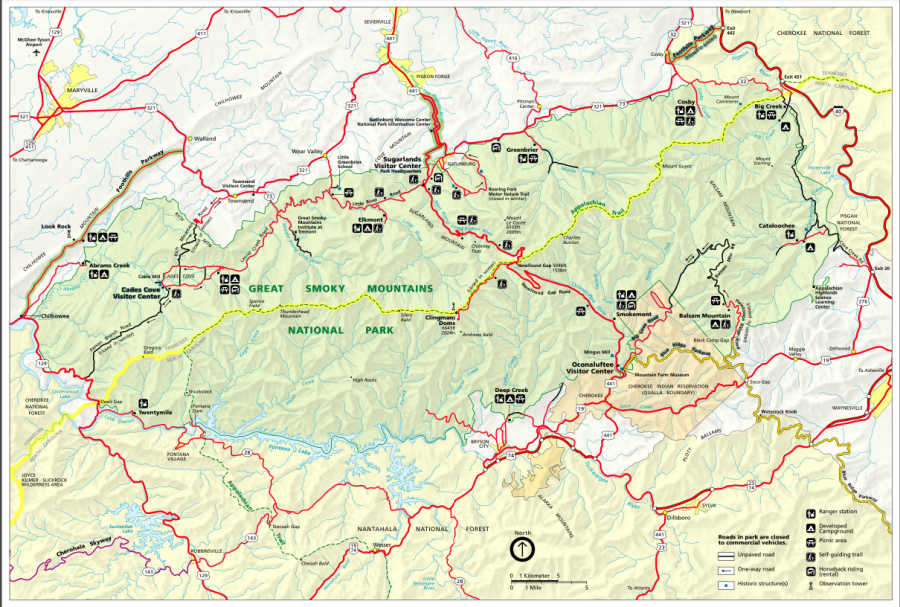
For a more detailed map, we really like the National Geographic Trails Illustrated Maps available on Amazon.
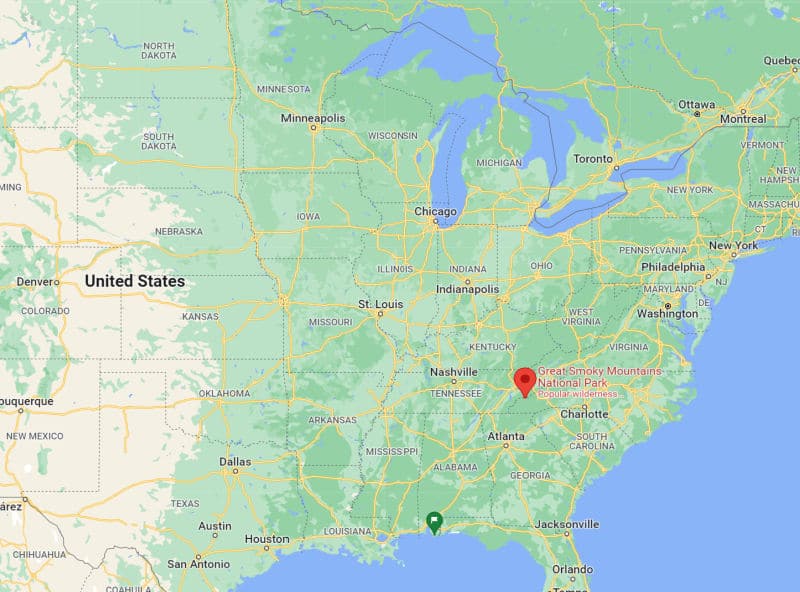
Where is Great Smoky Mountains NP?
The expansive Great Smoky Mountains National Park in the Eastern United States spans across the border of Tennessee and North Carolina. Elevation in the park ranges from 875 ft to 6,643 ft.
It is connected to nearby areas (including the Shenandoah National Park) via the scenic Blue Ridge Parkway and is close to iconic cities like Gatlinburg (TN), Townsend (TN), and Cherokee (NC).
Estimated distance from major cities nearby
Gatlinburg, Tennessee - 1.7 miles
Cherokee, North Carolina - 2.7 miles
Bryson City, North Carolina - 12.9 miles
Knoxville, Tennessee - 36.7 miles
Asheville, North Carolina - 37.1 miles
Chattanooga, Tennessee - 107 miles
Charlotte, North Carolina - 152 miles
Nashville, Tennessee - 204 miles
Estimated Distance from nearby National Park
Congaree National Park - 205 miles
Shenandoah National Park - 350 miles
Mammoth Cave National Park - 213 miles
Cuyahoga Valley National Park - 521 miles
Indiana Dunes National Park - 548 miles
New River Gorge National Park - 247 miles
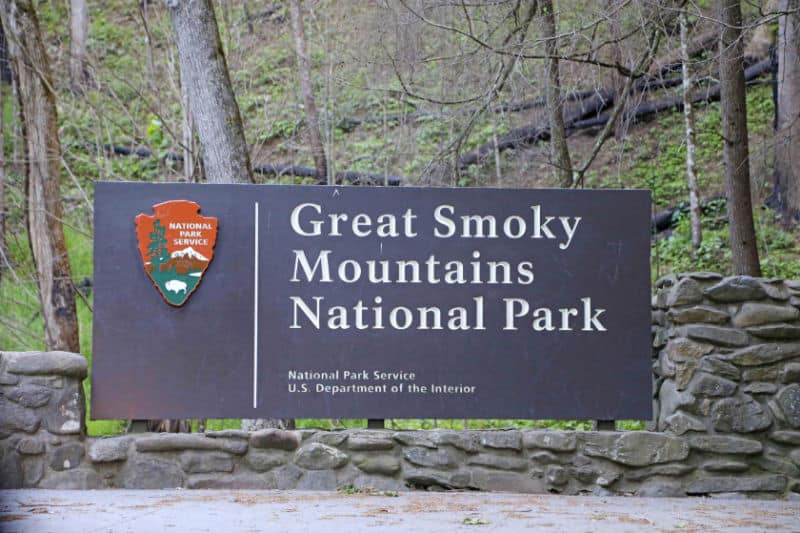
Where is the National Park Visitor Center?
Sugarlands Visitor Center
Open 364 days/year, closed on Christmas day.
Opening hours vary according to the season:
Winter - 9:00 am to 4:30 pm
Spring - 9:00 am to 5:00 pm / 6:00 pm (depending on the month)
Summer - 9:00 am to 7:00 pm
Fall - 9:00 am to 5:00 pm / 6:00 pm (depending on the month)
1420 Little River Road, Gatlinburg, TN 37738
The Sugarlands Visitor Center is located near the park’s main northern entrance, two miles south of Gatlinburg along US Route 441, the Newfound Gap Road.
Here you’ll be able to watch a free-of-cost 20-minute film about the park, observe natural history exhibits, and peruse the items at its bookstore and gift shop.
Ranger-led programs are conducted seasonally at this visitor center. It is fully equipped with public restrooms, the Backcountry Permit Office, and vending machines for beverages.
Oconaluftee Visitor Center
Open 364 days/year, closed on Christmas day.
Opening hours vary according to the season:
Winter - 9:00 am to 4:30 pm
Spring - 9:00 am to 5:00 pm / 6:00 pm (depending on the month)
Summer - 9:00 am to 7:00 pm
Fall - 9:00 am to 5:00 pm / 6:00 pm (depending on the month)
The Oconaluftee Visitor Center is located at the park’s main southern entrance, two miles north of Cherokee along US Route 441, the Newfound Gap Road.
Here you’ll be able to witness cultural history exhibits, browse through the bookstore and shop, and even get a chance to explore the adjacent Mountain Farm Museum, which has a farmhouse, smokehouse, apple house, and more. Ranger-led programs are conducted seasonally at this visitor center.
It is fully equipped with public restrooms and a vending machine for snacks and beverages.
Open 364 days/year, closed on Christmas day.
Opening hours vary according to the season:
Winter - 9:00 am to 4:30 pm
Spring - 9:00 am to 5:00 pm / 6:00 pm (depending on the month)
Summer - 9:00 am to 7:00 pm
Fall - 9:00 am to 5:00 pm / 6:00 pm (depending on the month)
Cades Cove Visitor Center is located off US Route 321, about 12 miles southwest of Townsend, Tennessee.
It is home to several indoor, and outdoor exhibits of Southern Mountain life and culture, the most popular of all is a grist mill that operates spring through fall.
You can also explore the bookstore and shop, the Becky Cable house, and other ancient structures. Ranger-led programs are conducted seasonally at this visitor center.
Clingmans Dome Visitor Contact Station
Open from April to November.
Opening hours vary according to the season:
Spring - 10:00 am to 6:00 pm
Summer - 10:00 am to 6:30 pm
Fall - 10:00 am to 5:00 pm / 6:00 pm (depending on the month)
It is located at the Clingmans Dome trailhead, 7 miles off US-441 on the Clingmans Dome Road.
It has a bookstore and shop, park information, and public restrooms for your use.
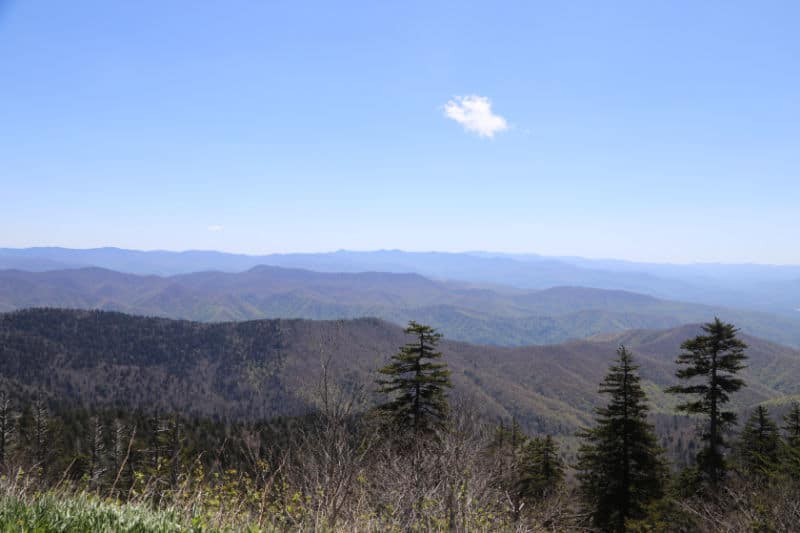
Getting to Great Smoky Mountains NP
International Airports
Greenville-Spartanburg International Airport (GSP) - 151 miles
Charlotte Douglas International Airport (CLT) - 192 miles
Hartsfield-Jackson Atlanta International Airport (ATL) - 202 miles
Nashville International Airport (BNA) - 224 miles
Regional Airports
McGhee Tyson Airport - 41 miles
Asheville Regional Airport - 89 miles
Chattanooga Airport (CHA) - 154 miles
Driving Directions
There are three main entrances to the park, and since the park’s area spans over two states, it’s essential to plan.
Gatlinburg, Tennessee Entrance
From Interstate 40, you’ll take Exit 407 (towards Sevierville) and get on Tennessee Route 66 South. At the Sevierville intersection, you’ll follow US Route 441 South through Sevierville and Pigeon Forge until you reach the park entrance.
Townsend, Tennessee Entrance
From Interstate 40 in Knoxville, you’ll take Exit 386B (towards Maryville) to get onto US Route 129 South. You’ll go on to take Tennessee Route 73 East towards Townsend. Continuing on this road will get you to the park’s entrance.
Cherokee, North Carolina Entrance
From Interstate 40, you’ll take Exit 27 (towards Waynesville) to get on US Route 74 West. You’ll then get on US Route 19 and drive through Maggie Valley into Cherokee. Then, you’ll turn onto Us Route 441 North, and you’ll reach the park’s entrance.
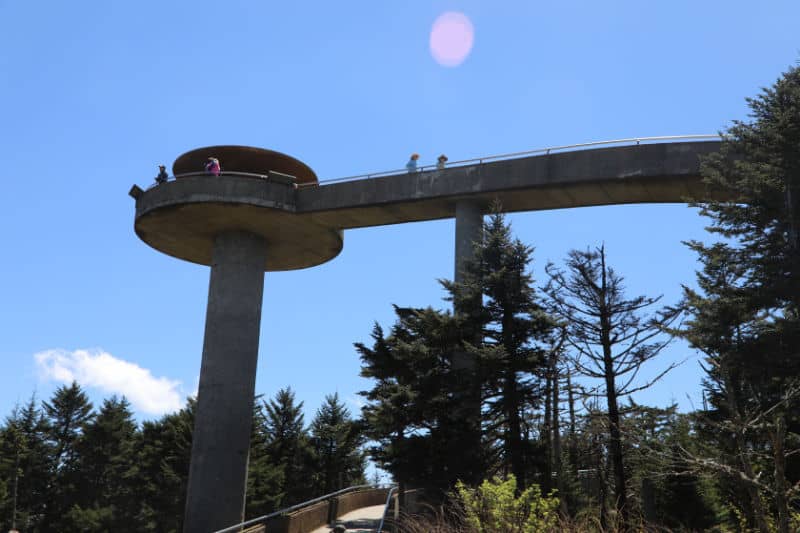
Best time to visit Great Smoky Mountains National Park
The majestic Great Smoky Mountains National Park is an all-weather park, and your trip is sure to be memorable no matter when you visit; however, visiting during different seasons will lead to varied experiences and opportunities.
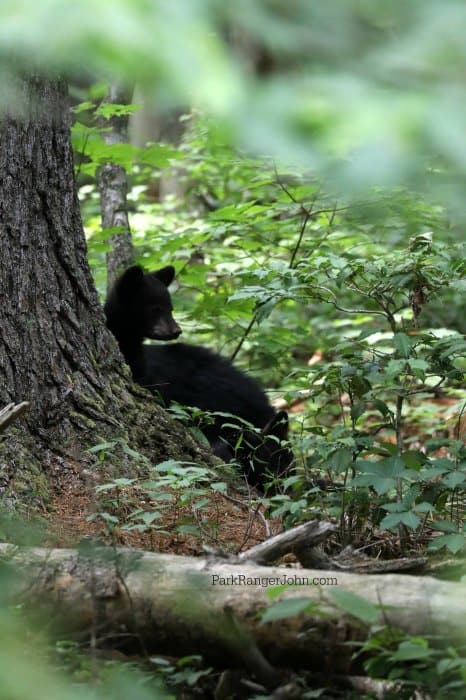
Great Smoky Mountains National Park Weather and Seasons
The weather in the Smokies is very temperate but is different at various elevations. At higher elevations, it may be 10 to 20 degrees colder than at lower elevations.
Springtime may be the best time to go, and smell all the flowers growing with temperatures reaching the 70's to the '80s. In the summer it is very hot, hazy and humid, and the temperature can go into the high 90's.
With all the waterfalls though, there's always a possibility of cooling off. In autumn the daytime highs reach into the 70's and 80's. The first frost happens late in September, and in November the lows are near freezing.
Always be prepared or changes in weather by dressing in layers. March and July are usually the wettest months in the park.
Spring
With such a diverse climate and varying topography, the weather can be unpredictable. In the Spring (March to May), it is known to change from sunny to snow-clad within a day.
March is notorious for sudden snowfall, especially in the mountains. By mid-April, the weather becomes more pleasant, and eventually, May’s weather is pretty warm.
Summer
The summertime (June to August) in the Great Smoky Mountains is harsh with humidity and heat, accompanied by frequent thunderstorms.
During this time, the temperature in the afternoons is an average of 90 (high) and 70 (low) and gets more pleasant in the evenings.
On Mount Le Conte (the third-highest peak in the park), the temperature doesn’t go above 80. Summer is the peak season among tourists, so if you’re looking to avoid crowds, this may not be the ideal time.
Autumn/Fall
The autumn (September to mid-November) is one of the best times to visit the park because not only is the weather bearable, but you can immerse yourself with the picturesque fall foliage.
The average high starts in the 70s in September and goes done to the 50s by mid-November. During this time, the park barely receives any rainfall; however, snowfall is possible in higher elevation regions by November.
October is pretty crowded as the fall foliage is a favorite amongst everybody so if you’re visiting then, be sure to plan to combat the crowds.
Winter
The winter (mid-November to February) in the Great Smoky Mountains is mild, with some extreme exceptions. The weather can vary drastically between areas of lower elevation and higher elevation.
The average high can reach the 70s in the day, but most nights can be below zero. At higher elevations, an average low of -20 can also be expected. Snowfall is a frequent occurrence and is found best in January and February.
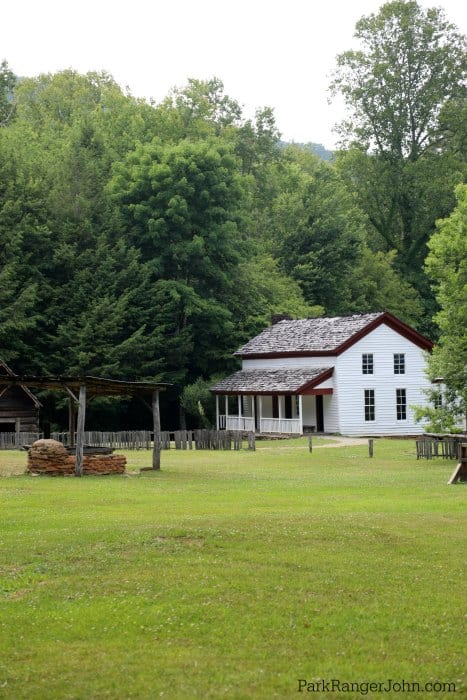
Best Things to do in Great Smoky Mountains National Park
There are so many great things to do in Great Smoky Mountains NP!
Self driving tour available to help while you are in the park.
There are also guided tours available of the park.
Guided Tours
Guided tours are a great way to learn about the park. You don't have to worry about driving and can enjoy the epic scenery.
From Pigeon Forge - Valley and Views Jeep Tour
Explore the Great Smoky Mountains with a 2.5-hour tour on one of the most scenic drives in eastern Tennessee.
From Pigeon Forge - Wears Valley Helicopter Tour
See spectacular mountain views as you fly over the historic Sevierville and experience the wilderness of Pine Mountain and the breathtaking Wears Valley from above.
From Pigeon Forge - 2.5 hour Roaring Fork Jeep Tour
Travel through Roaring Fork Motor Nature Trail. Take in the sights of the shops and Smoky Mountain attractions from your seat in a custom-built, open-air Pink Jeep Wrangler. Finish your 2.5 hour tour with an exciting 4x4 off-road adventure.
From Pigeon Forge - 3 hour Foothills Parkway Jeep Tour
Explore the breathtaking beauty of the Foothills Parkway and the Smokey Mountains on a 3-hour Jeep tour. Discover a route touted by many as “the prettiest drive in America".
Cades Cove
One of the most famous landmarks in the park, Cades Cove, is a great place to observe the wildlife in the Great Smoky Mountains.
You may encounter cows, deer, and turkey, among many other sites symbolic of the park’s ancient past, like churches and historic cabins.
The loop road is 11-miles long and great for cycling, mainly before 10 am as cars are allowed only after that. You’ll be able to learn more about the region’s history and the people who inhabited it for years before you.
As you soak in the scenic views of the fields, you’ll be able to feel the energy of those who truly nurtured and loved the nature around you.
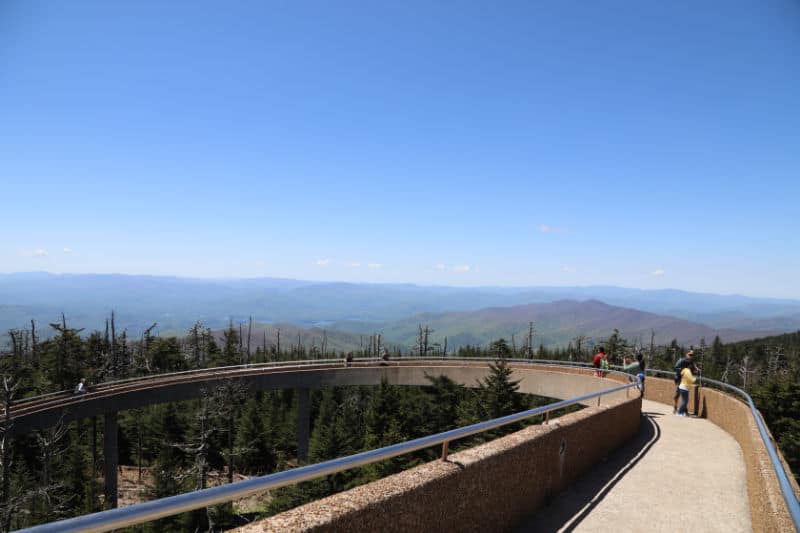
Clingmans Dome
The Clingmans Dome is one of the most well-known attractions of the Great Smoky Mountains National Park.
It is popular because it is a cement structure located on top of the highest peak in the park (at 6,643 ft) and has a view that will literally take your breath away.
As the highest point in all of Tennessee, the vistas from this unique structure, especially during sunrise and sunset, are gorgeous.
Cataloochee
A region within the park with historic buildings, wildlife, and an incredibly tranquil atmosphere, you can’t visit the Great Smokies and not go to Cataloochee.
It is home to buildings of historical importance like two old-time churches, homesteads, and schools that date back to the late 19th and early 20th centuries.
The valley is surrounded by Smoky peaks that look like they can touch the sky, making you feel so big and so small at the same time.
At Cataloochee, you’ll be able to camp, go fishing, hike one of the many trails in the area, and so much more.
Waterfalls
There’s so much that the park has to offer; however, one of the must-see attractions is the waterfalls within the region.
The sound of the beautiful cascading waterfalls echoes through the woods.
Some of the well-known waterfalls you can explore are Laurel Falls, Grotto Falls, Hen Wallow Falls (which is massive at 90 foot tall), and more. You may also be able to spot some wildlife lounging near these waterfalls.
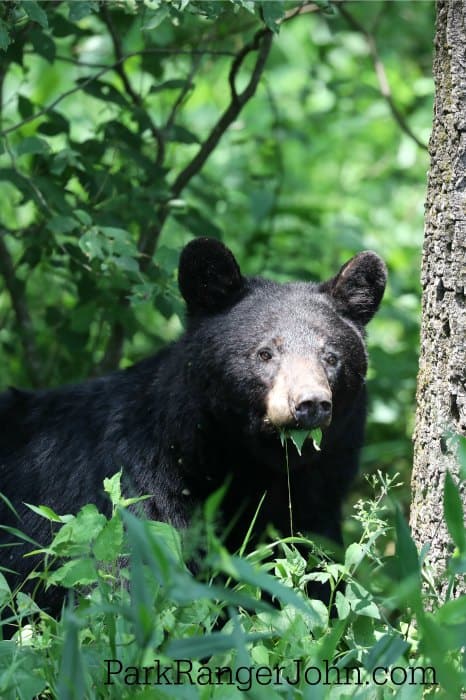
Wildlife viewing
There are many creatures to spot in the expansive park that extends over 500,000 acres. You may be able to spot the Black grizzly Bear, White-Tailed Deer, Elk, Chipmunk, and many other animals.
The park is home to over 200 species of birds and is also known as the Salamander Capital of the world, with over 30 different species, amongst other aquatic life.
After the sun goes down, you’ll also be able to spot the unique synchronous fireflies (which are one among 19 other firefly species in the park) that’ll light up the night as you’ve never witnessed before.
Junior Ranger Program
You can pick up a Junior Ranger booklet for $2.50 at any park visitor center or at the Cades Cove or Elkmont campground.
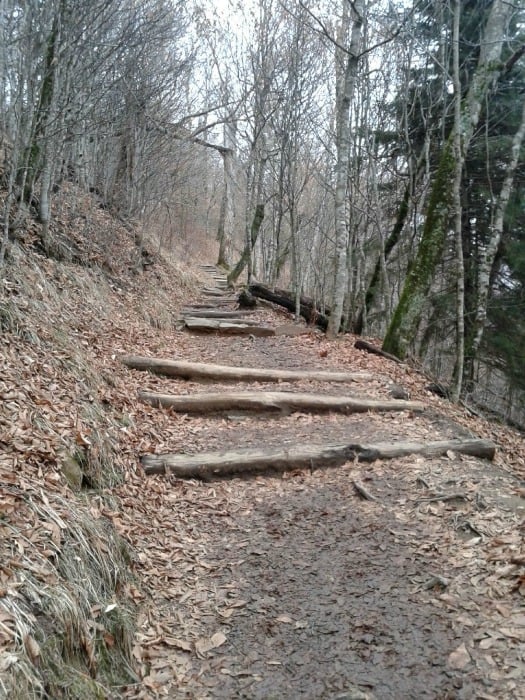
Hiking in Great Smoky Mountains National Park
The Great Smoky Mountains National park is truly a hiker’s paradise with an interconnected web of 800 miles of trails; you’re always bound to have a different path to hike.
The trails vary as per difficulty, accessibility, and elevation, so you can choose the ones that best work for you and your companions.
While in the park, you’ll have the chance to hike a portion of the infamous Appalachian Trail!
No matter which trails you choose to traverse, always carry the ten essentials for outdoor survival when exploring the beautiful sights of the park.
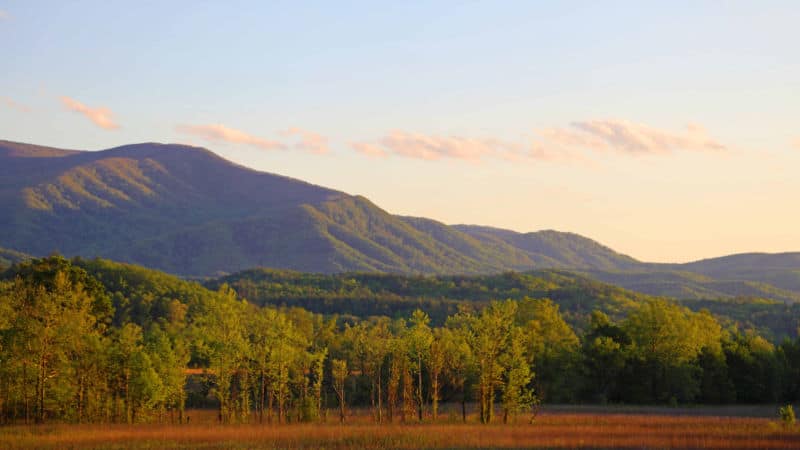
How to beat the crowds in Great Smoky Mountains National Park?
As the most visited National Park in the country, it’s improbable that you’ll ever find Great Smoky Mountains National Park deserted; however, visiting during the off-season or in specific hours of the day can help.
If you choose to visit during the summer (peak season), it’s ideal to arrive at the park before 10 am or after lunchtime to avoid large crowds.
The other peak season is October, as people love to visit during the fall time because the park comes alive with all sorts of colors, so avoid visiting then if you want to see the attractions without a crowd.
In the winter, several attractions and campgrounds may not be open, so plan ahead for that.
The famous landmarks like the Newfound Gap Road and Cades Cove Loop Road attract the most crowds, so try to visit unique attractions like the Heintooga Ridge Road, Abrams Falls, Greenbrier Cove, and others.
Where to stay when visiting National Park
There are many options right outside of the park in Gatlinburg and Pigeon Forge, Tennessee.
There is one park lodge the LeConte Lodge which you visitors need to hike into.
LeConte Lodge
Sitting at 6,643 ft, just shy of the Mountain LeConte peak at 6,593 feet, is the LeConte Lodge. This beautiful property is the only Lodge within the National Park.
It boasts spectacular unobstructed views of the mountains and the valley; however, it is only accessible by foot (which you’ll have to follow with your supplies).
There are five trails that will lead you to this historic site - Alum Cave Trail, Boulevard Trail, Bullhead Trail, Rainbow Falls Trail, and Trillium Gap Trail, each varying in distance and elevation, so be sure to plan.
The Lodge is entirely old-school (has no water or electricity), so you’ll have plenty of time to just soak in the breathtaking scenery and picturesque mountains. The Lodge doesn’t offer much beyond the basic amenities and serves regular family-style Southern food for breakfast, lunch, and dinner.
If you’re looking to detox from any electronics and just become one with nature under the twilight sky, the LeConte Lodge situated high up in the mountains is the perfect place to spend the night.
You can make a reservation at the Lodge by calling: (865) 429-5704 or emailing reservations@lecontelodge.com.
Lodging near Great Smoky Mountains NP
Fairfield Inn & Suites by Marriott Gatlinburg - We have stayed in this hotel the past few times we visited the park and it has been great. Fairfield Inn & Suites by Marriott Gatlinburg Downtown provides free continental breakfast, a terrace, and dry cleaning/laundry services. For some rest and relaxation, visit the hot tub. Stay connected with free in-room Wi-Fi, and guests can find other amenities such as a fireplace in the lobby and a gym.
Margaritaville Resort Gatlinburg - Located close to Ripley's Aquarium of the Smokies, Margaritaville Resort Gatlinburg provides a firepit, a coffee shop/café, and a garden. Indulge in a massage, a body scrub, and a facial at St. Somewhere Spa, the onsite spa. Enjoy a meal at the two onsite restaurants. Free in-room Wi-Fi is available to all guests, along with laundry facilities and a bar.
Hampton Inn Gatlinburg - Hampton Inn Gatlinburg Historic Nature Trail provides free self-serve breakfast, a firepit, and a garden. Free in-room Wi-Fi is available to all guests, along with dry cleaning/laundry services and a gym.
Glenstone Lodge - Glenstone Lodge provides amenities like a terrace and a 24-hour business center. Stay connected with free in-room Wi-Fi.
The Park Vista - a DoubleTree by Hilton Hotel - provides a terrace, a garden, and a playground. For some rest and relaxation, visit the hot tub. Enjoy a meal at the two onsite restaurants. In addition to dry cleaning/laundry services and a fireplace in the lobby, guests can connect to free Wi-Fi in public areas.
Hilton Garden Inn Gatlinburg - provides golfing on site, dry cleaning/laundry services, and a fireplace in the lobby. For some rest and relaxation, visit the hot tub. The onsite restaurant, Garden Grille, features happy hour. Free in-room Wi-Fi is available to all guests, along with a bar and a gym.
Click on the map below to see additional hotels and vacation rentals near Great Smoky Mountains.
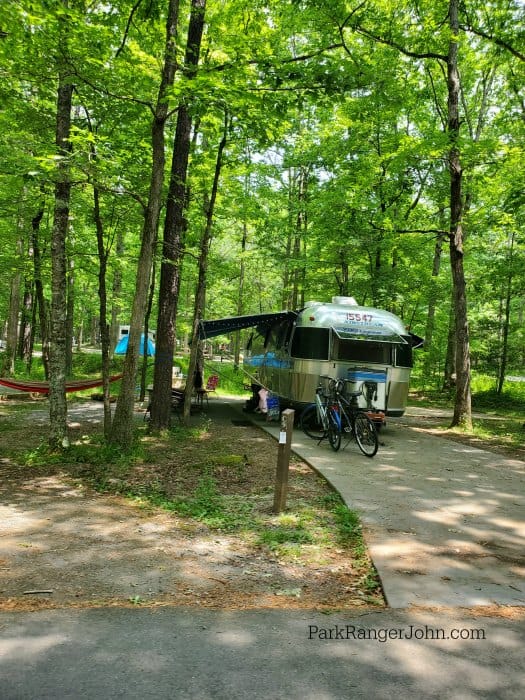
Great Smoky Mountains Camping
There are multiple campgrounds spread throughout the park, some near the mountains and others in fields where animals roam free.
The camping facilities in the park may not be ideal for beginner campers as there are no water facilities or electricity hookups.
Some campgrounds require reservations, while others work on a first-come, first-serve basis.
Most campgrounds have RV spaces limited to 21 feet or shorter, while others have RV spaces that permit vehicles up to 35 feet.
Abrams Creek Campground
Season: April to October
Campsites: 16 (tent-only)
It is located in a remote area 43 miles from Gatlinburg at an elevation of 1,125 ft. It requires a reservation up to 6 months before your travel. There are no showers, water facilities, or electricity hookups. It costs $17.50/night.
Balsam Mountain Campground
Season: May to October
Campsites: 42 (tent-only)It is located in a remote area 9 miles from the Black Camp Gap entrance. It is set at an elevation of 5,310 ft, so you’ll have a view of the valley. It requires a reservation. There are no showers, water facilities, or electricity hookups. It costs $17.50/night.
Big Creek Campground
Season: May to October
Campsites: 12 (tent-only)
Located in the Eastern segment of the park, it’s set at 1,700 ft elevation and is one of the most peaceful sites. It requires a reservation. There are no showers, water facilities, or electricity hookups. It costs $17.50/night.
Cades Cove Campground
Season: Year-Round
Campsites: 159 (35-40 foot RVs are permitted)
Located next to the popular Cades Cove, at an elevation of 1,807 ft, is the Cades Cove Campground in the park’s heart. It requires reservations and has a fire ring, running water, a camp store (the ice-cream machine is excellent!), and flush toilets. It is pretty busy in the summertime, so make sure you book in advance, and it costs $21-$25/night.
Cataloochee Campground
Season: June - November
Campsites: 27 (31 foot RVs are permitted)
It is located in the ancient Cataloochee Valley, at a 2,610 ft elevation, and full of rich history. It requires a reservation up to 6 months before your travel and costs $25/night.
Cosby Campground
Season: May to October
Campsites: 157 (25 foot RVs are permitted)
It is located in a remote area, a 30-minute drive from Gatlinburg at an elevation of 2,459 ft. About 42 campsites are open for advance booking, while you can access the remaining 115 campsites via first-come, first-serve. The campground has fire rings, flush toilets, the camp host on-site, and costs $17.50/night.
Deep Creek Campground
Season: May - November
Campsites: 92 (25 foot RVs are permitted)
It is located by one of the well-known creeks in the park at an elevation of 1,800 ft. It has grills, tables, and vampire rings, perfect for a family picnic or friend’s cookout! It is first-come, first-serve only and costs $21/night.
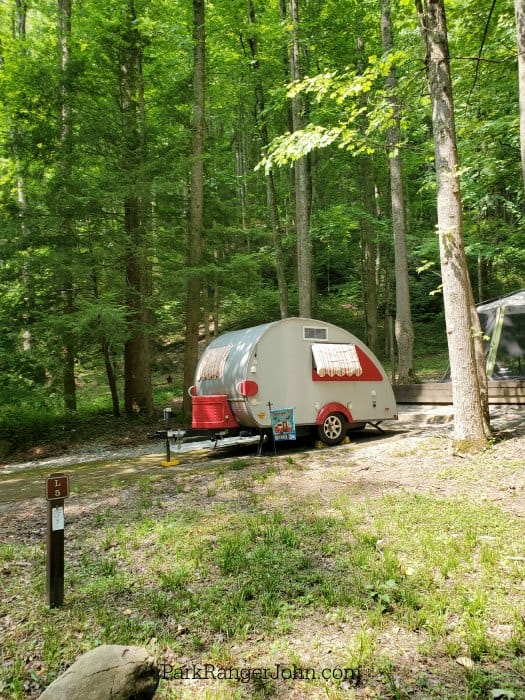
Elkmont Campground
Season: March to November
Campsites: 220 (32 - 35 foot RVs are permitted; out of the 220 sites, 9 are wheelchair accessible ADA sites)
It is the campground closest to the city of Gatlinburg and is set at an elevation of 2,150 ft. it is the biggest campground in the park, and you can reserve a spot six months in advance on a rolling basis. It has firewood for sale, the camp host on-site, and flush toilets and costs $21 - $27/night.
Smokemont Campground
Season: Year-Round
Campsites: 142 (35 - 40 foot RVs are permitted)
It is located by the Newfound Gap Road (US Route 441) at 2,198 ft. It requires a reservation in advance. It has tent pads, fire rings, grills, drinking water, flush toilets, and sinks and costs $21 - $25/night.
Look Rock Campground
The Look Rock Campground is currently closed for repairs.

For a fun adventure check out Escape Campervans. These campervans have built in beds, kitchen area with refrigerators, and more. You can have them fully set up with kitchen supplies, bedding, and other fun extras. They are painted with epic designs you can't miss!
Escape Campervans has offices in Vancouver, Seattle, Portland, San Francisco, Las Vegas, Los Angeles, Phoenix, Salt Lake City, Denver, New York, and Orlando
Travel Tips
The Great Smoky Mountains National Park is open 24 hours per day and all 365 days and it is free.
Be prepared for animal jams to slow down travel time
Give yourself time to explore the park.
The roads are pretty twisty in some sections of the park. If you or a passenger get car sick to be prepared. My wife rarely gets car sick and she was not feeling great during the drive due to all the turns.
Be prepared for crowds! Great Smoky Mountains NP gets the most visitors in the National Parks system!
One day is not enough time to fully enjoy this park!
Slow down and enjoy the journey, don’t just focus on the destination. Give yourself more time than you think you will need!
Be prepared for animal jams. We ended up driving through Cade's Cove at a crawl due to a couple of deer on the side of the road everyone was taking pictures of. It is a 1 lane road and not very fast going when we were there.
If you are wondering about accessibility within the park check out our friend Cory Lee's post -> Wheelchair Accessible Guide to Great Smoky Mountains National Park.
Important Great Smoky Mountains Telephone Numbers
Backcountry reservations 865-436-1297
Special Services 865-436-1200
Road/weather conditions 865-436-1200
Gatlinburg CVB 865 436-4178
Parks near Great Smoky Mountains NP
Andrew Johnson National Historic Site - 40 miles
Big South Fork National River & Recreation Area - 60 miles
Blue Ridge Parkway - Adjacent to national park in North Carolina
Carl Sandburg Home National Historic Site - 50 miles
Chickamauga & Chattanooga National Military Park- 120 miles
Cumberland Gap National Historical Park - 95 miles
Check out all of the National Parks in North Carolina along with neighboring National Parks in Georgia, National Parks in South Carolina, Tennessee National Parks, and Virginia National Parks

